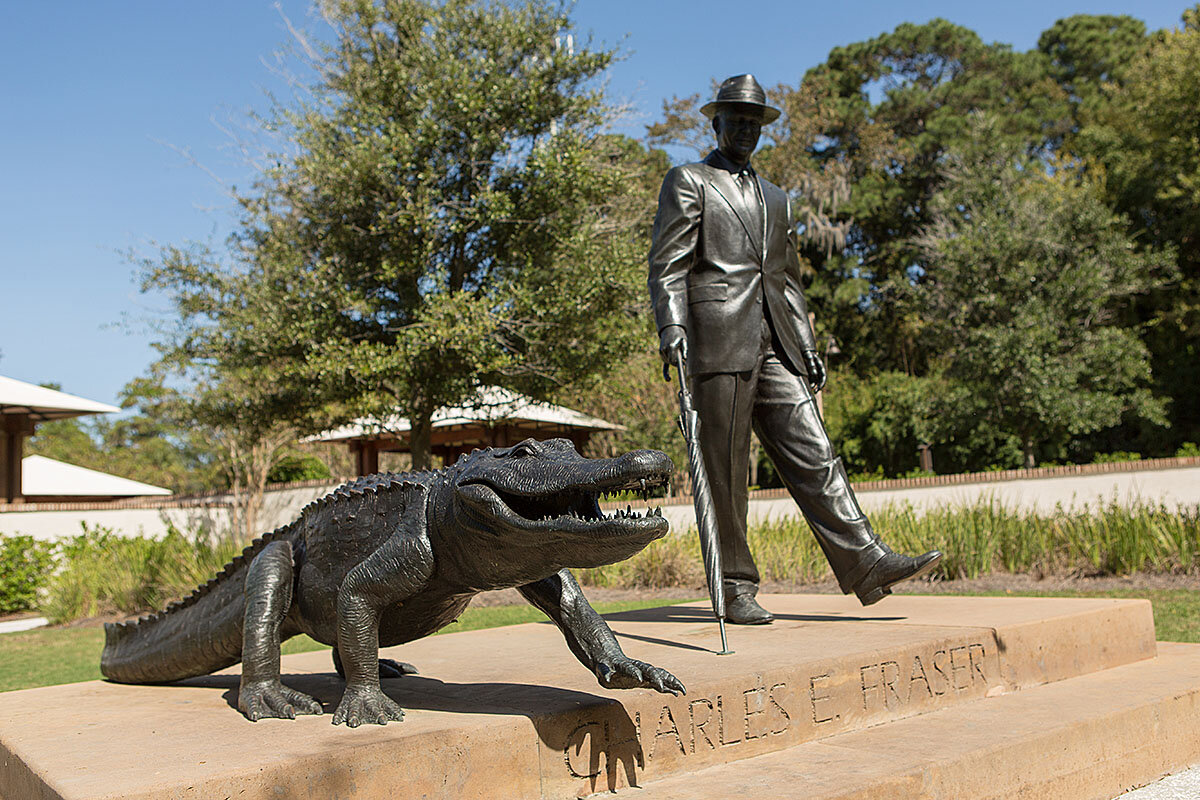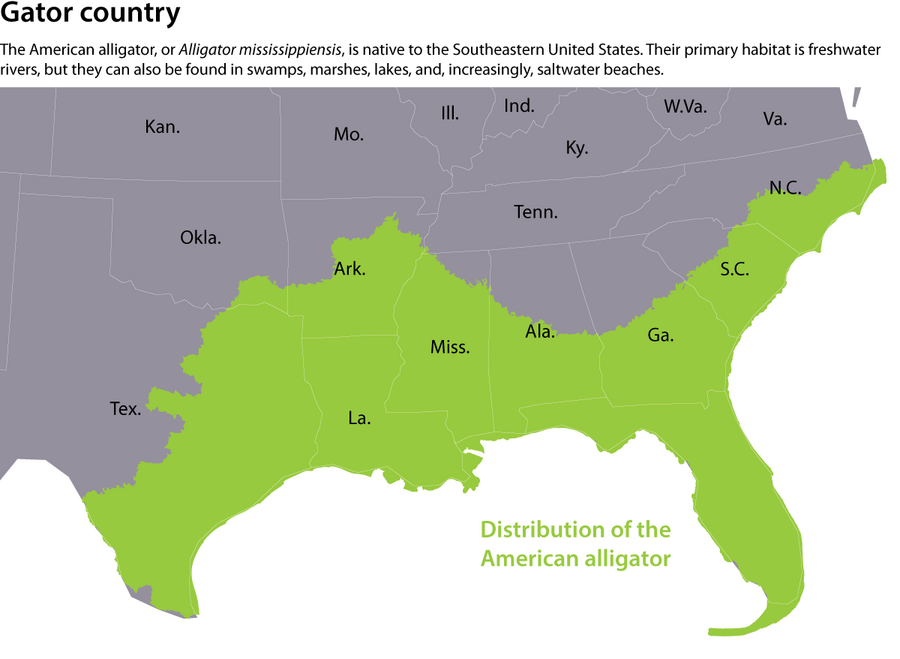Close encounters: Are these gators lost – or just learning to get along?
Loading...
| Tybee Island, Ga.
Residents on South Carolina’s Hilton Head Island are used to living with alligators. But this summer, the gators’ presence has become more pronounced. First they started to appear on saltwater beaches, something practically unheard of before. Then, more tragically, a woman was killed by an alligator while she was walking her dog. The attack underscores the potential for dire consequences when humans and wild predators come into conflict. And the appearance of alligators on saltwater beaches suggests that human-gator encounters may become more common. It’s a scenario that’s playing out across America, as apex predators push their way into human communities – and vice versa. Whether based on fear, competition, or resource-harvesting, manifest destiny drove apex predators deeper into the wilds. It was thought that ever-diminishing resources would thus doom many species. But it appears that a generation of ecologists may have underestimated the adaptability of some of these species. These animals have demonstrated remarkable ability to adapt to humanity’s influence on the environment. It remains to be seen whether people will be willing to adapt to accommodate them as neighbors.
Why We Wrote This
Surprise alligator sightings on South Carolina’s saltwater beaches are challenging residents’ and researchers’ notions of where these fearsome predators belong.
For many residents and tourists, alligators have long been a part of Hilton Head Island’s charm.
The South Carolina resort town’s first developer once appeared in the Saturday Evening Post strolling alongside an alligator. (A lifesize bronze reproduction of that scene now adorns the town’s Compass Rose Park.) Today, tourists at the The Sea Pines Resort can take have their photo taken with resort mascot Albert the Alligator and numerous tour companies offer excursions to see Alligator mississippiensis in its natural freshwater habitat.
But this summer, the gators’ presence has become more pronounced. First they started to appear on saltwater beaches, something practically unheard of before. Then, more tragically, a woman was killed by an alligator on Monday while she was walking her dog near a golf-course lagoon.
Why We Wrote This
Surprise alligator sightings on South Carolina’s saltwater beaches are challenging residents’ and researchers’ notions of where these fearsome predators belong.
Monday’s shocking incident – it has been decades since a gator killed anyone in South Carolina – underscores the potential for dire consequences when humans and wild predators come into conflict. And the appearance of alligators on saltwater beaches suggests that human-gator encounters may become more common.
That’s a scenario that’s playing out across America, as apex predators are pushing their way into human communities – and vice versa.
Experts say any peace will come from the extent to which policymakers and denizens are willing to tolerate a gradual wilding of America.
“We are now having to think about whether we can coexist with large, fierce animals, and whether we will change and modulate our behavior in a way to do that,” says Duke University wildlife biologist Andrew Read. “Some species pose challenges, and we’re going to have to dig down and figure out ways to do that.”
Whether based on fear, competition, or resource-harvesting, manifest destiny drove apex predators deeper into the wilds. It was thought that ever-diminishing resources would thus doom many species. Florida panthers and bears were on the brink, and the American alligator was set to go the way of the stegosaurus by the mid-1970s. Bald eagles, too, nearly saw their reign end, victims of insecticide poisoning.
But it appears that a generation of ecologists may have underestimated the adaptability of some of these species. Yes, apex predator populations were at a near-nadir, which built assumptions about habitat and population dynamics for a generation of scientists. But now, conservation efforts combined with a decline in hunting pressure appear to have lit an ancestral beacon for growing numbers of fearsome creatures.
American alligators in saltwater were until recently thought of by ecologists as anomalies. Yet when researchers started stumbling across them crunching on crabs in salt-water estuaries, they realized that something more profound was happening.
Ecologists are also observing killer whales venturing far into freshwater creeks, sea otters moving from kelp beds to estuaries, and the Florida panther cautiously expanding its range. Wolves are descending into maritime environments and black bears becoming an urban demographic across the South. Sometimes such homecomings are intertwined, tooth and nail. Hot on the flippers of newly-arrived gray seals off Cape Cod? White sharks.
“Ecologists simply got it wrong when they didn’t expect to see alligators on the coast,” says University of Florida cultural ecologist John Richard Stepp. “The baseline was the wrong date. When you go back in archaeological data, we’ve found coastal settlements with alligator remains mixed into the middens.”
Coexisting with predators
Much like humans, the large size of these predators has given them greater habitat adaptability. In the case of gators, a form of intelligence has enabled them to make critical “metabolic tradeoffs,” says Professor Stepp, noting that salt water “may not be the very best habitat, but it works for them.”
But what is happening behaviorally is perhaps even more interesting.
North Carolina had 2,000 black bears in the early 1970s. There are now over 20,000 across the state, including several hundred living inside the city limits of Asheville, the Appalachian hippie outpost.
An ongoing bear-tagging study shows that the city bears are fatter, healthier, and have more cubs per litter than their country cousins.
“There are so many human sources of food for bears that bears are eating really well in Asheville,” says Mike Carraway, the mountain region supervisor for the North Carolina Wildlife Resources Commission. But bears also seem to be embracing courtesy. “It is as much bears learning to coexist with people as it is people learning to coexist with bears.”
As large predators expand across the continent, it will require more people to confront their primal fears.
“Wildness is something engineered into humans, but we have so little common experience with it [now] that we forget or never recognize it,...” says Georgia Tech marine biologist Mark Hay, in an email from Budapest.
There can be profound benefits. Large predators can accomplish major feats of ecological balancing, perhaps key amid climate change. Sea otters expanding into estuaries are dining on large numbers of Dungeness crabs, which allows a beneficial sea slug – a sort of estuarine vacuum cleaner – to flourish.
But conflicts are also forcing the hands of natural resource managers.
The return of the alligator has led to a large-scale commercial harvest in Louisiana. Florida added 1,313 more alligator permits in July, in addition to 5,000 usually handed out. South Carolina introduced a hunt in 2008 after years of complaints about large gators menacing people along canals, with some 5,500 hunters now harvesting up to two gators each.
But at least one gator hunter says coexisting with large, fierce predators is ultimately less about control – and more about common sense.
“There was alligators on Hilton Head before there was a house, and we encroached on their territory,” says Dennis Matherly, a retired gator hunter who has pulled gators out of the Myrtle Beach surf. “They are adapting, and they are having to adapt to us. I’ve been doing this so long I take the gator’s side. The general public more and more are raised in a Walt Disney mentality, and the real world don’t work like that. Mother Nature is not nice.”










